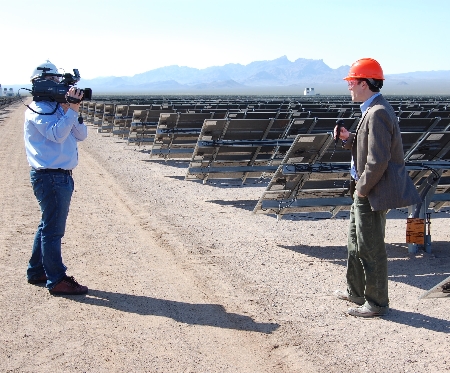Optimism Abounds Throughout Renewable Energy Industry
Last week the editors at RenewableEnergyWorld.com and Renewable Energy World magazine traveled to Las Vegas to attend the 6th annual Renewable Energy World North America (REWNA) Conference and Expo. With almost twice the attendance of last year's event and more than double the exhibitors, the show's exponential growth in spite of a dismal economy is a testament to the strength of the renewable energy industry.
The problems for companies created by the
recession are apparent. But the enthusiasm and recognition of the incredible
prospects for renewables dominated the discussion.
The editors started the week with a tour of the El Dorado thin-film solar facility (see lead photo). The 10-MW project is the largest thin-film installation in North America, covering 88 acres with 167,400 First Solar Cadmium Telluride panels.
When the conference started, editors roamed the conference floor gathering a range of video interviews with analysts and business executives on new technologies and policy developments.
Interested in tracking what's happening in the broader clean tech space? Check out our conversation with RenewableEnergyWorld.com contributing writer Clint Wilder on Clean Edge's Clean Energy Trends 2009 Report, which includes the 5 key technologies to watch in clean tech as well as Wilder's comments on the state of the industry.
One of the most popular energies in the space is algae. While there weren't many algae companies at the conference, there was still a lot of talk about what role this prolific organism will play in the fuel market. Editor Jennifer Runyon spoke with Mark Braly about what experts are saying about this burgeoning industry.
Of course, finance is a big issue in the renewable energy space. Braly and Runyon also sat down to talk about the lack of project finance and what types of projects are actually getting the capital to move forward. Braly talked about utility PV projects as well, which are rapidly gaining ground. According to the Solar Electric Power Association, there are now 2,200 MW of projects being pushed forward by 10 utilities around the U.S. This made utility involvement in the solar industry a hot topic at the conference.
While interest in traditional PV is still growing, new solar technologies are sprouting up everywhere, increasing the amount of attention the industry is getting. Stephen Lacey spoke with one of the oldest players in the Concentrating PV space, Amonix, about what the increased competition means for well-established players.
Darren Kimura, CEO of Sopogy, also spoke with Lacey about the company's micro-CSP parabolic trough collectors, which are extending the solar thermal industry to a variety of meet on-site generation needs.
Sopogy is currently working on a major project in Spain — one of many solar projects being developed for the country's very hot solar market. But the 2009 cap on installations will certainly dampen the Spanish industry's growth this year, which may provide more incentive for Spain-based companies to branch out into other markets. Brian Gaylord, a market analyst for the Spanish Trade Commission, talked with Lacey about the growing international presence of Spanish companies.
This trend is certainly being felt here in the U.S. wind industry as companies from Spain and other European countries buy up and develop American wind assets. News Editor Graham Jesmer spoke with the new CEO of the American Wind Energy Association, Denise Bode, about the incredible growth in foreign and U.S. wind businesses, which put around 8,300 MW of capacity online last year.
Wind is a great resource to harvest, but there is also a need to harvest more stable forms of baseload renewables. The answer is geothermal, said Geothermal Energy Association Executive Director Karl Gawell in an interview with Jesmer.
We may see a slowdown in wind and other renewables well into this year, but the recent stimulus package, which sets aside $67 billion for clean energy, energy efficiency and smart-grid technologies may reverse that downward trend. Jesmer caught up with John McKinsey of the law firm Stoel Rives to talk about when the stimulus may have an impact. He also talked with Piper Jaffray's Chris Flannery about the details of the program and the need to create more project finance opportunities for the industry.
All in all, the conference was a great success. The problems for companies created by the recession are apparent. But the enthusiasm and recognition of the incredible prospects for renewables dominated the discussion. We hope you enjoy the interviews. We'll see you next year in Austin, Texas.
 To subscribe or visit go to:
http://www.renewableenergyaccess.com
To subscribe or visit go to:
http://www.renewableenergyaccess.com
